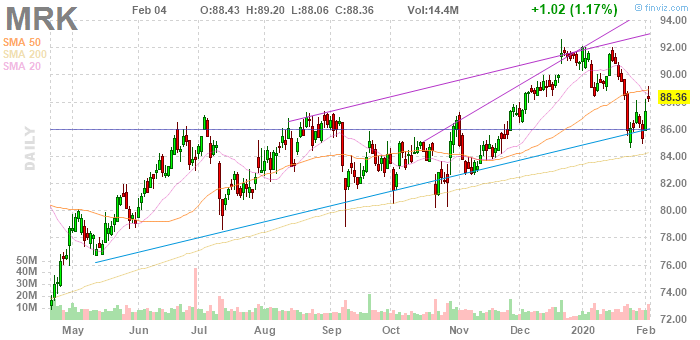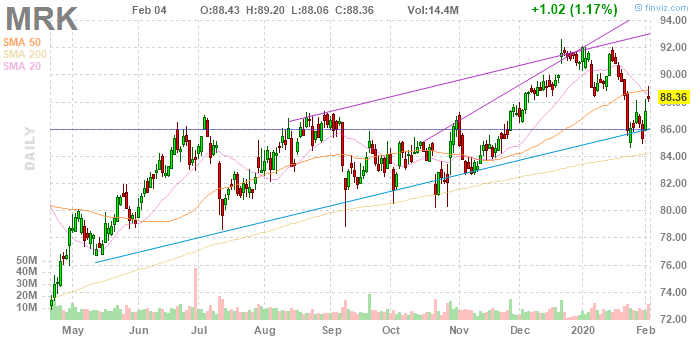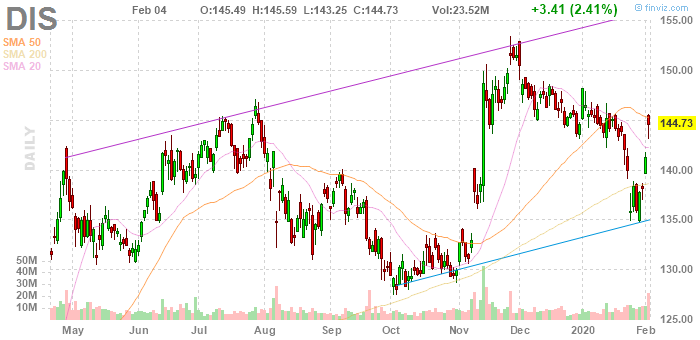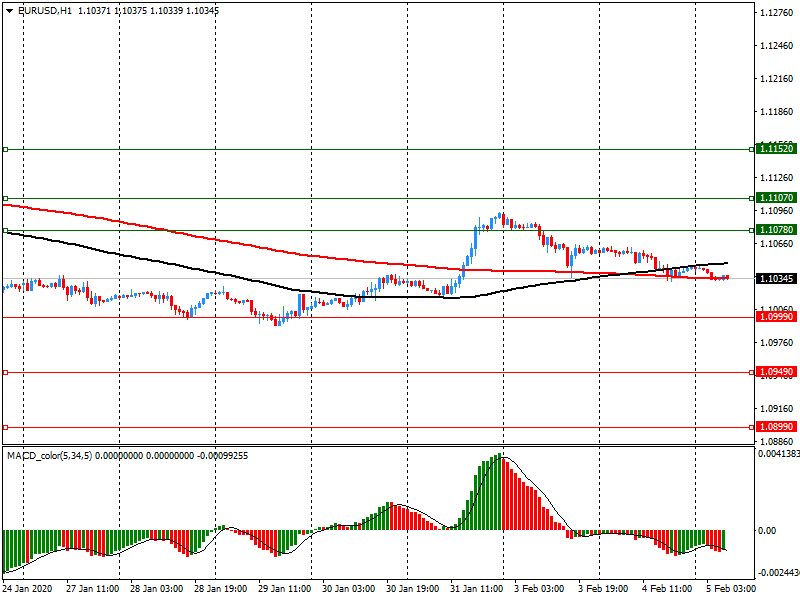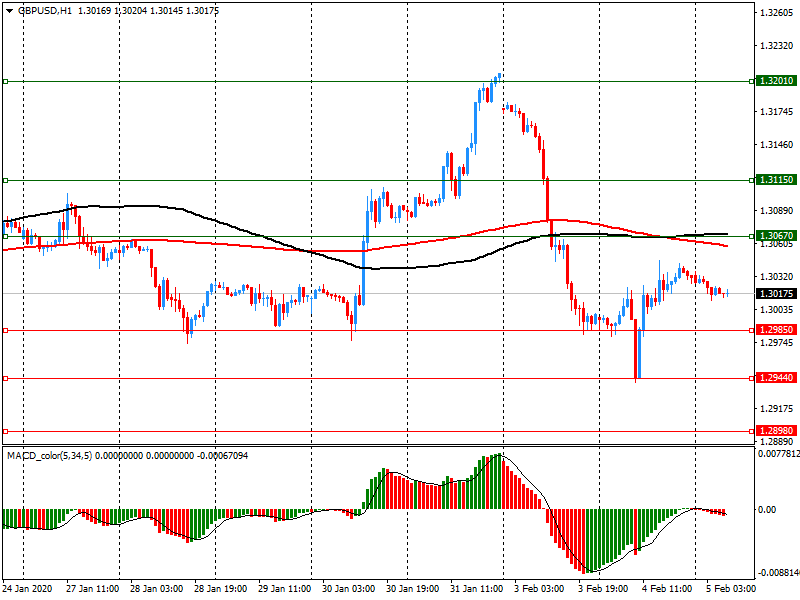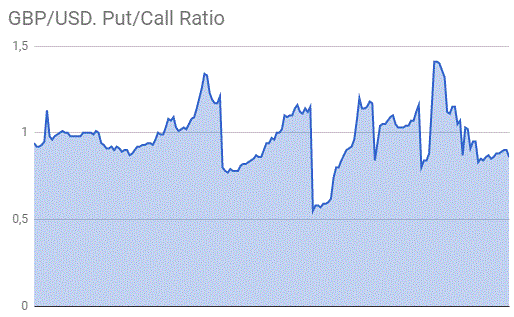- Analiza
- Novosti i instrumenti
- Vesti sa tržišta
Forex-novosti i prognoze od 05-02-2020
| Time | Country | Event | Period | Previous value | Forecast |
|---|---|---|---|---|---|
| 00:30 | Australia | Trade Balance | December | 5.8 | 5.95 |
| 00:30 | Australia | Retail Sales, M/M | December | 0.9% | -0.2% |
| 07:00 | Germany | Factory Orders s.a. (MoM) | December | -1.3% | 0.6% |
| 08:00 | Eurozone | ECB President Lagarde Speaks | |||
| 09:00 | Eurozone | ECB Economic Bulletin | |||
| 10:00 | Eurozone | EU Economic Forecasts | |||
| 13:30 | U.S. | Continuing Jobless Claims | January | 1703 | 1720 |
| 13:30 | U.S. | Initial Jobless Claims | February | 216 | 215 |
| 13:30 | U.S. | Unit Labor Costs, q/q | Quarter IV | 2.5% | 1.4% |
| 13:30 | U.S. | Nonfarm Productivity, q/q | Quarter IV | -0.2% | 1.6% |
| 14:15 | U.S. | FOMC Member Kaplan Speak | |||
| 21:30 | Australia | AIG Services Index | January | 48.7 | |
| 22:30 | Australia | RBA's Governor Philip Lowe Speaks | |||
| 23:30 | Japan | Labor Cash Earnings, YoY | December | -0.2% | |
| 23:30 | Japan | Household spending Y/Y | December | -2% | -1.7% |
| Time | Country | Event | Period | Previous value | Forecast |
|---|---|---|---|---|---|
| 00:30 | Australia | Trade Balance | December | 5.8 | 5.95 |
| 00:30 | Australia | Retail Sales, M/M | December | 0.9% | -0.2% |
| 07:00 | Germany | Factory Orders s.a. (MoM) | December | -1.3% | 0.6% |
| 08:00 | Eurozone | ECB President Lagarde Speaks | |||
| 09:00 | Eurozone | ECB Economic Bulletin | |||
| 10:00 | Eurozone | EU Economic Forecasts | |||
| 13:30 | U.S. | Continuing Jobless Claims | January | 1703 | 1720 |
| 13:30 | U.S. | Initial Jobless Claims | February | 216 | 215 |
| 13:30 | U.S. | Unit Labor Costs, q/q | Quarter IV | 2.5% | 1.4% |
| 13:30 | U.S. | Nonfarm Productivity, q/q | Quarter IV | -0.2% | 1.6% |
| 14:15 | U.S. | FOMC Member Kaplan Speak | |||
| 21:30 | Australia | AIG Services Index | January | 48.7 | |
| 22:30 | Australia | RBA's Governor Philip Lowe Speaks | |||
| 23:30 | Japan | Labor Cash Earnings, YoY | December | -0.2% | |
| 23:30 | Japan | Household spending Y/Y | December | -2% | -1.7% |
FXStreet reports that in the opinion of economists at Standard Chartered Bank Europe and the Pacific region can use fiscal policies to cushion the impact of coronavirus.
“The euro area, Australia, New Zealand, the Philippines, Indonesia, Malaysia, and Taiwan all have room to add to their fiscal deficits, without this leading to an increase in their debt to GDP ratios, even in the short term.”
“However, a number of economies that already have a projected deficit that exceeds this differential would likely have to accept a higher level of debt to GDP to further support their economies.”
“Following any extra stimulus to counter the coronavirus shock, deficits would need to come in below real funding costs minus GDP growth spread in order to bring the policy back to a more sustainable path.”
The U.S. Energy Information Administration (EIA) revealed on Wednesday that crude inventories climbed by 3.355 million barrels in the week ended January 31. Economists had forecast an advance of 2.831 million barrels.
At the same time, gasoline stocks edged down by 0.091 million barrels, while analysts had expected a gain of 2.057 million barrels. Distillate stocks declined by 1.512 million barrels, while analysts had forecast a decrease of 0.014 million barrels.
Meanwhile, oil production in the U.S. dropped by 100,000 barrels a day to 12.900 million barrels a day.
U.S. crude oil imports averaged 6.6 million barrels per day last week, down by 46,000 barrels per day from the previous week.
The Institute for Supply Management (ISM) reported on Wednesday its non-manufacturing index (NMI) came in at 55.5 in January, which was 0.6 percentage points higher than the revised December-2019 reading of 54.9 (originally 55.0 percent). This pointed to the biggest expansion in the services sector since August.
Economists forecast the index to stay at 55 last month. A reading above 50 signals expansion, while a reading below 50 indicates contraction.
Of the 18 manufacturing industries, 12 reported growth last month, the ISM said, adding that the respondents remain mostly positive about business conditions and the overall economy but note difficulty with labor resources.
According to the report, the ISM's non-manufacturing business activity measure rose to 60.9 percent, up 3.9 percentage points from December reading of 57.0 percent. That reflected growth for the 126th consecutive month, at a faster rate in January. The New orders gauge increased to 56.2 percent; up 0.9 percentage point from 55.3 percent in December. Meanwhile, the Employment indicator fell 1.7 percentage points in January to 53.1 percent from the seasonally adjusted December reading of 54.8 percent. The Prices Index reading dropped 3.8 percentage points to 55.5 from the December reading of 59.3 percent.
U.S. stock-index futures surged on Wednesday, supported by media reports of a treatment to fight the fast-spreading coronavirus.
Global Stocks:
| Index/commodity | Last | Today's Change, points | Today's Change, % |
| Nikkei | 23,319.56 | +234.97 | +1.02% |
| Hang Seng | 26,786.74 | +110.76 | +0.42% |
| Shanghai | 2,818.09 | +34.80 | +1.25% |
| S&P/ASX | 6,976.10 | +27.40 | +0.39% |
| FTSE | 7,487.05 | +47.23 | +0.63% |
| CAC | 5,993.06 | +58.01 | +0.98% |
| DAX | 13,474.32 | +192.58 | +1.45% |
| Crude oil | $50.86 | | +2.52% |
| Gold | $1,559.60 | | +0.26% |
(company / ticker / price / change ($/%) / volume)
| 3M Co | MMM | 159.25 | 2.01(1.28%) | 8884 |
| ALCOA INC. | AA | 15.28 | 0.58(3.95%) | 51121 |
| ALTRIA GROUP INC. | MO | 46.67 | 0.15(0.32%) | 3152 |
| Amazon.com Inc., NASDAQ | AMZN | 2,073.00 | 23.33(1.14%) | 70380 |
| American Express Co | AXP | 133.44 | 1.59(1.21%) | 790 |
| Apple Inc. | AAPL | 322.7 | 3.85(1.21%) | 634896 |
| AT&T Inc | T | 37.7 | 0.07(0.19%) | 32864 |
| Boeing Co | BA | 320.52 | 2.58(0.81%) | 24765 |
| Caterpillar Inc | CAT | 135.28 | 1.77(1.33%) | 8403 |
| Chevron Corp | CVX | 108.25 | 1.40(1.31%) | 11737 |
| Cisco Systems Inc | CSCO | 48.31 | 0.69(1.45%) | 36451 |
| Citigroup Inc., NYSE | C | 77.8 | 1.30(1.70%) | 21672 |
| Deere & Company, NYSE | DE | 166.1 | 1.67(1.02%) | 2141 |
| Exxon Mobil Corp | XOM | 60.75 | 0.78(1.30%) | 145533 |
| Facebook, Inc. | FB | 212.45 | 2.62(1.25%) | 141119 |
| FedEx Corporation, NYSE | FDX | 149.39 | 1.88(1.27%) | 6985 |
| Ford Motor Co. | F | 8.47 | -0.71(-7.73%) | 3509499 |
| Freeport-McMoRan Copper & Gold Inc., NYSE | FCX | 12.3 | 0.26(2.16%) | 74243 |
| General Electric Co | GE | 12.7 | 0.12(0.96%) | 176484 |
| General Motors Company, NYSE | GM | 35.05 | 0.68(1.98%) | 531787 |
| Goldman Sachs | GS | 245.25 | 3.31(1.37%) | 8586 |
| Google Inc. | GOOG | 1,457.55 | 10.48(0.72%) | 23669 |
| Home Depot Inc | HD | 237.5 | 2.50(1.06%) | 3290 |
| HONEYWELL INTERNATIONAL INC. | HON | 176.54 | 1.33(0.76%) | 257 |
| Intel Corp | INTC | 66.58 | 1.12(1.71%) | 140429 |
| International Business Machines Co... | IBM | 150.23 | 1.12(0.75%) | 19723 |
| Johnson & Johnson | JNJ | 152.8 | 1.20(0.79%) | 128675 |
| JPMorgan Chase and Co | JPM | 137.4 | 2.11(1.56%) | 25364 |
| McDonald's Corp | MCD | 215.5 | 0.88(0.41%) | 2140 |
| Merck & Co Inc | MRK | 85.45 | -2.91(-3.29%) | 252573 |
| Microsoft Corp | MSFT | 183.8 | 3.68(2.04%) | 513855 |
| Nike | NKE | 101.48 | 0.10(0.10%) | 25023 |
| Pfizer Inc | PFE | 37.92 | 0.23(0.61%) | 12737 |
| Procter & Gamble Co | PG | 126.66 | 1.00(0.80%) | 1541 |
| Starbucks Corporation, NASDAQ | SBUX | 88.85 | 0.88(1.00%) | 20981 |
| Tesla Motors, Inc., NASDAQ | TSLA | 859.69 | -27.37(-3.09%) | 1097236 |
| The Coca-Cola Co | KO | 59.03 | 0.19(0.32%) | 5541 |
| Twitter, Inc., NYSE | TWTR | 34.15 | 0.19(0.56%) | 83991 |
| Verizon Communications Inc | VZ | 58.57 | 0.28(0.48%) | 27306 |
| Visa | V | 205.85 | 2.29(1.13%) | 27147 |
| Wal-Mart Stores Inc | WMT | 115.86 | 0.59(0.51%) | 3309 |
| Walt Disney Co | DIS | 145.4 | 0.67(0.46%) | 303109 |
| Yandex N.V., NASDAQ | YNDX | 49.08 | 1.07(2.23%) | 21216 |
Statistics Canada announced on Wednesday that Canada's merchandise trade deficit stood at CAD0.37 billion in December, narrowing from a revised CAD1.20 billion gap in November (originally a CAD1.09-billion gap).
Economists had expected a deficit of CAD0.61 billion.
According to the report, the country's exports rose 1.9 percent m-o-m in December, primarily due to higher crude oil exports (+18.0 percent m-o-m). Meanwhile, imports increased 0.2 percent m-o-m in December, led by a gain in imports of consumer goods (+4.0 percent m-o-m).
For 2019, Canada's trade deficit totaled $18.3 billion, the smallest gap since 2014. The country's total exports rose 1.7 percent in 2019, while total imports grew 1.0 percent.
Tesla (TSLA) downgraded to Hold from Buy at Canaccord Genuity
The U.S. Commerce Department reported on Wednesday that U.S. the goods and services trade deficit rose 11.9 percent m-o-m to $48.9 billion in December from a revised $43.7 billion in the previous month (originally a gap of $43.1).
Economists had expected a deficit of $48.2 billion.
According to the report, the December increase in the goods and services deficit reflected a gain in the goods deficit of $5.1 billion to $69.7 billion and a drop in the services surplus of $0.1 billion to $20.8 billion. Exports of goods and services from the U.S. rose 0.8 percent m-o-m to $209.6 billion in December, while imports jumped 2.7 percent m-o-m to $258.5 billion.
For the full 2019, the goods and services deficit declined 1.7 percent from 2018. That was the first decline since 2013. Exports edged down 0.1 percent in 2019, while imports reduced 0.4 percent.
Merck (MRK) reported Q4 FY 2019 earnings of $1.16 per share (versus $1.04 per share in Q4 FY 2018), beating analysts' consensus estimate of $1.15 per share.
The company's quarterly revenues amounted to $11.868 bln (+7.9% y/y), beating analysts' consensus estimate of $11.705 bln.
MRK fell to $85.60 (-3.12%) in pre-market trading.
General Motors (GM) reported Q4 FY 2019 earnings of $0.05 per share (versus $1.43 per share in Q4 FY 2018), beating analysts' consensus estimate of $0.01 per share.
The company's quarterly revenues amounted to $30.826 bln (-19.7% y/y), missing analysts' consensus estimate of $31.765 bln.
The company also issued downside guidance for FY 2020, projecting EPS of $5.75-6.25 versus analysts' consensus estimate of $6.28.
GM rose to $34.57 (+0.58%) in pre-market trading.
The employment report prepared by Automatic Data Processing Inc. (ADP) and Moody's Analytics showed on Wednesday the U.S. private employers added 291,000 jobs in January.
Economists had expected a gain of 155,000.
The increase for December was revised down to 199,000 from the originally reported 202,000.
"The labor market experienced expanded payrolls in January," noted Ahu Yildirmaz, vice president and cohead of the ADP Research Institute. "Goods producers added jobs, particularly in construction and manufacturing, while service providers experienced a large gain, led by leisure and hospitality. Job creation was strong among midsized companies, though small companies enjoyed the strongest performance in the last 18 months."
Meanwhile, Mark Zandi, chief economist of Moody's Analytics, said, "Mild winter weather provided a significant boost to the January employment gain. The leisure and hospitality and construction industries in particular experienced an outsized increase in jobs. Abstracting from the vagaries of the data underlying job growth is close to 125,000 per month, which is consistent with low and stable unemployment."
Walt Disney (DIS) reported Q1 FY 2020 earnings of $1.53 per share (versus $1.84 per share in Q1 FY 2019), beating analysts' consensus estimate of $1.44 per share.
The company's quarterly revenues amounted to $20.858 bln (+36.3% y/y), roughly in line with analysts' consensus estimate of $20.837 bln.
DIS rose to $145.04 (+0.21%) in pre-market trading.
| Time | Country | Event | Period | Previous value | Forecast | Actual |
|---|---|---|---|---|---|---|
| 08:50 | France | Services PMI | January | 52.4 | 51.7 | 51 |
| 08:55 | Germany | Services PMI | January | 52.9 | 54.2 | 54.2 |
| 09:00 | Eurozone | Services PMI | January | 52.8 | 52.2 | 52.5 |
| 09:30 | United Kingdom | Purchasing Manager Index Services | January | 50 | 52.9 | 53.9 |
| 10:00 | Eurozone | Retail Sales (MoM) | December | 0.8% | -0.9% | -1.6% |
| 10:00 | Eurozone | Retail Sales (YoY) | December | 2.3% | 2.4% | 1.3% |
| 12:15 | Eurozone | ECB President Lagarde Speaks |
CNY and AUD strengthened against their major counterparts on Wednesday as reports about a drug breakthrough against the coronavirus outbreak supported investors' appetite for risk. At the same time, safe havens such as JPY and CHF weakened against most major currencies.
Media reported that researchers at Zhejiang University in China had found a drug to treat people with the coronavirus, while scientists from Imperial College London in Britain had made a “significant breakthrough” in developing a vaccine, which is able to reduce the development time from “two to three years to just 14 days”.
The Australian currency was also boosted by some hawkish remarks by the Reserve Bank of Australia's (RBA) governor Philip Lowe.
Elsewhere, EUR fell against most of its rivals, weighted by disappointing retail sales data for Eurozone. According to the report from Eurostat, the Eurozone's seasonally adjusted volume of retail trade decreased by 1.6% m/m in December after a 0.8% m/m gain in November. Economists had expected a 0.9% drop. According to the report, the volume of retail trade fell by 1.6% m/m for non-food products and by 1.4% m/m for food, drinks and tobacco and automotive fuels.
Investors also digested the latest comments of the ECB's representatives. ECB's president Lagarde noted that short-term uncertainties for Eurozone "are mainly related to global risks – trade, geopolitical and now the outbreak of the coronavirus and its potential effect on global growth". She also added that "in the face of these uncertainties, the ECB’s forward guidance on interest rates and asset purchases acts as an effective automatic stabiliser".
Meanwhile, ECB's chief economist Philip Lane said he firmly believes that "the interest rate in the future will be higher" because of easy policy now, adding that "with recovery, the maximum achievable interest rate might be 2-3%."
- Says low rates are helping Germany get through slower growth period
- Sees improvement for inflation in coming years
- But not all the way to ECB's target
- Short-term uncertainties are mainly related to global risks
- These risks include trade, geopolitical and now the outbreak of the coronavirus and its potential effect on global growth
- Climate change will be a key part of our ongoing strategy review
The Mortgage Bankers Association (MBA) reported on Wednesday the mortgage application volume in the U.S. surged 5.0 percent in the week ended January 31, following a 7.2 percent surge in the previous week.
According to the report, refinance applications jumped 15.3 percent, while applications to purchase a home fell 9.5 percent.
Meanwhile, the average fixed 30-year mortgage rate dropped to 3.71 percent from 3.81 percent. That was the lowest level since October 2016.
"The 10-year Treasury yield fell around 20 basis points over the course of last week, driven mainly by growing concerns over a likely slowdown in Chinese economic growth from the spread of the coronavirus. This drove mortgage rates lower, with the 30-year fixed rate decreasing for the fifth time in six weeks," noted Joel Kan, MBA's associate vice president of economic and industry forecasting.
FXStreet reports that TD Securities is optimistic about the U.S. economic data being released today.
“We forecast the ISM non-manufacturing index to rise modestly to 55.3 in Jan following an already-strong 54.9 print in Dec. If confirmed, this should further support USD dominance over low-yielders such as the EUR.”
“We anticipate a strong surge in ADP employment for Jan at 230k, up from 202k, and expect the trade deficit to have widened to USD 48.8bn in Dec.”
“In Canada, international merchandise trade for December will give an update on Q4 growth conditions, with TD looking for the trade balance to narrow from -$1.1bn to a modest $100m deficit on the strength of exports (market: - $600m).”
FXStreet reports that FX Strategists at UOB Group expect USD/JPY to trade within a side-line theme in the near-term.
24-hour view: “USD staged a sudden and sharp jump as it closed higher by +0.77% (109.51). The advance appears to be running ahead of itself but there is room for USD to test 109.70 first before easing off. Support is at 109.20 followed by 109.00”.
Next 1-3 weeks: “Despite the relatively sharp USD decline to 108.30 last Friday, we indicated on Monday (03 Feb, spot at 108.45) that ‘downward momentum has not improved by as much’ and added, the ‘the prospect for a move to last month’s low near 107.65 is not high’. That said, the manner by which USD rocketed to a high of 109.54 yesterday came as a surprise (the +0.77% gain is the largest 1-day rise in 6 months). Downward pressure has dissipated but the near-term outlook is unclear. From here, USD is expected to trade sideways for a period, likely between the two major levels of 108.30 and 110.30.”
- Says coronavirus prevention and control is at a crucial stage
- Says will crack down on coronavirus-related rumour-mongering
- Must report coronavirus outbreak information timely and accurately
FXStreet reports that the impact of coronavirus in an important economy for emerging markets like China has strained these countries. Nordea is expecting a recovery for EM Markets, especially for commodity currencies.
"The second half of January proved to be stressful for emerging markets amid worries around the coronavirus outbreak in China. EM currencies lost on average 2%, the key pattern of the current increased volatility is that commodity currencies (RUB, CLP, ZAR, BRL, COP) find themselves under particular pressure."
"Markets seem to be stabilising for now as the pace of the virus spread has started to decrease. Massive liquidity injections by the PBoC have also contributed to calming down the markets. Should this stabilisation prove to be sustainable, commodity currencies may slightly outperform the rest of the EM currencies in the coming month."
"If the markets get more proof that the virus spread is under control, we expect EM currencies to gradually regain ground. Continued liquidity injections, notably by the Fed, will remain one of the supporting factors for risky assets and risk appetite. We have previously noted that dollar liquidity tends to lead EM FX."
FXStreet reports that AUD/USD must be kept on track today as the pair should show signs of recovery, Karen Jones from Commerzbank analyses.
"AUD/USD is attempting to stabilise ahead of the .6671 October low and yesterday charted a key day reversal. We should see further some signs of recovery towards .6800 and possibly the 200-day ma at .6867"
"The 2016-2020 support line lies at .6658, and these should ideally hold."
"The market will need to close above January's high at .6933 to alleviate downside pressure and reassert attention to the .7031 end of December high."
According to the report from Eurostat, in December 2019 compared with November 2019, the seasonally adjusted volume of retail trade decreased by 1.6% in the euro area (EA19) and by 1.3% in the EU27. Economists had expected a 0.9% decrease. In November 2019, the retail trade volume increased by 0.8% in the euro area and by 0.9% in the EU27.
In December 2019 compared with December 2018, the calendar adjusted retail sales index increased by 1.3% in the euro area and by 1.9% in the EU27.
The average retail trade for the year 2019, compared with 2018, rose by 2.2% in the euro area and by 2.4% in EU27.
In the euro area in December 2019, compared with November 2019, the volume of retail trade decreased by 1.6% for non-food products and by 1.4% for food, drinks and tobacco and automotive fuels. In the EU27, the volume of retail trade decreased by 1.6% for non-food products, by 1.3% for food, drinks and tobacco and by 0.9% for automotive fuels.
In the euro area in December 2019, compared with December 2018, the volume of retail trade increased by 3.6% for non-food products while food, drinks and tobacco decreased by 0.7% and automotive fuel by 3.7%. In the EU27, the retail trade volume increased by 4.0% for non-food products while food, drinks and tobacco decreased by 0.3% and automotive fuel by 2.6%.
According to the report from IHS Markit/CIPS, January data pointed to a solid recovery in the performance of the UK service sector, with business activity, new work and employment all expanding at a faster pace than seen at the end of 2019. Survey respondents widely commented that improved business and consumer confidence had translated into rising client demand.
At 53.9 in January, up from 50.0 in December, the seasonally adjusted UK Services PMI Business Activity Index registered in expansion territory for the first time since last August. Economists had expected an increase to 52.9. The latest reading was the highest for 16 months and above the earlier 'flash' estimate of 52.9 in January, to signal a solid increase in service sector output. Survey respondents noted that the headwind from delayed decision-making had lifted since the general election and helped to deliver a return to business activity growth in January. This was also reflected in a robust improvement in order intakes, with the rate of new business expansion accelerating to its strongest since June 2018.
The UK Composite Output Index
At 53.3 in January, up from 49.3 in December, the seasonally adjusted UK Composite Output Index posted above the neutral 50.0 mark for the first time since last August. The latest reading signalled a faster pace of growth than the earlier 'flash' estimate (52.4 in January) and was the highest for 16 months. The solid increase in private sector output was driven by a return to growth in the service economy (index at 53.9) and supported by a broad stabilisation in manufacturing production at the start of 2020 (index at 50.1).
According to the report from IHS Markit, Eurozone PMI Composite Output Index strengthened for a second successive month at the start of 2020. Rising to 51.3, from 50.9 in December and above the earlier flash reading, the index indicated a modest rate of growth, but nonetheless the highest recorded by the survey since last August.
Expansion of the private sector was again driven by the services economy during January, although growth here was softer than in the previous month. Manufacturing output continued to fall, extending the current sequence of contraction to a full year. However, the rate of decline was the weakest recorded by the survey since last June.
All nations covered by composite PMI data recorded an expansion in private sector output during January. Ireland led the way, expanding at its fastest pace in just under a year.
The Eurozone PMI Services Business Activity Index was a little lower during January, falling to 52.5, from 52.8 in the previous month. Weaker expansion reflected slower service sector gains in France and Spain. All other nations registered stronger growth compared to December.
A solid increase in new work was signalled during January, with growth unchanged on December's four-month high. Companies again took on additional staff, with employment rising at a solid pace that was slightly stronger than the previous month. Additional capacity helped firms to broadly keep on top of their workloads as backlogs rose only marginally.
Finally, business confidence about the future was the strongest recorded since last April. With the exception of Spain - where sentiment fell to its joint-lowest in over six years - optimism was higher across the region during January.
FXStreet reports that according to strategists at Standard Chartered Bank, the perception that Donald Trump's re-election is likely in November might have some holes, as national polls show Trump losing against most the democratic contenders. In the short term, who wins the Democratic nomination will be the most important focus.
"Multiple indicators have combined to create a perception that Donald Trump's re-election is likely in November. However, national polls have consistently shown that Trump is more likely to lose in presidential match-ups against most of the Democratic contenders."
"Election outcomes will be determined by who wins the Democratic nomination and how the US economy is doing, or feels like it is doing, heading into the vote."
"Election day turnout will be another key factor, with higher turnout tending to benefit Democrats; and, most importantly, how voting in a few crucial swing states affects Electoral College votes."
Danske Research discusses EUR/USD outlook and adopts a sell-0n-rallies bias.
"Virus fears have led markets to call for rate cuts. Mounting expectations of the Fed in this regard have notably been a common factor across G10 and EM, but is now the time to position for Fed-driven reflation and a EUR/USD rebound? We doubt it," Danske notes.
"We suggest using spikes in EUR/USD to position for new dip in 1.10-1.13 range," Danske adds.
FXStreet reports that according to FX Strategists at UOB Group, EUR/USD could likely move into a consolidative phase unless it resumes the upside in the near-term.
24-hour view: "In line with our expectation, EUR traded sideways yesterday even though the registered range of 1.1031/1.1064 is narrower than our expected range of 1.1035/1.1085. Momentum indicators are still mostly neutral and the current movement is still viewed as part of a consolidation phase. In other words, we continue to expect EUR to trade sideways, likely between 1.1030 and 1.1070."
Next 1-3 weeks: "EUR dropped to a low of 1.1031 before ending the day on a soft note at 1.1042 (-0.14%). The pick-up in momentum from last Friday's (31 Jan) strong surge to 1.1096 has eased considerably. From here, unless EUR recover above 1.1070 within these 1 to 2 days, a breach of 1.1015 (no change in 'strong support' level) would indicate that our view from Monday (03 Feb, spot at 1.1090) for the rebound in EUR to extend further is premature. To put it another way, unless EUR recover soon, the current price action looks more akin to be part of a consolidation phase instead of a strong rebound."
| Time | Country | Event | Period | Previous value | Forecast | Actual |
|---|---|---|---|---|---|---|
| 01:30 | Australia | RBA's Governor Philip Lowe Speaks | ||||
| 01:45 | China | Markit/Caixin Services PMI | January | 52.5 | 52.6 | 51.8 |
| 06:45 | Switzerland | SECO Consumer Climate | Quarter I | -10.3 | -9.4 |
The US dollar rose slightly against the euro and weakened against the yen, as demand for safe haven assets remains high amid the continued spread of the coronavirus in China and beyond.
Over the past day, the number of infected people in the country increased by 3.887 thousand people, and deaths - by 65, all recorded in Hubei province, which is the epicenter of the spread of the coronavirus.
"The reaction of Asian currencies is understandable, given how the situation with the coronavirus is developing," said Eddi Chung, an analyst at emerging markets Credit Agricole CIB. "We have yet to see the impact of the epidemic on economic growth in China and Asia as a whole."
US President Donald trump, who won the Republican Caucus in Iowa earlier this week with 97% of the vote, addressed the nation in the US Congress on Tuesday. He talked about the" incredible results " of his administration's economic policy and the rosy prospects for the US economy.
At the same time, the first and incomplete results of voting at The democratic party's Caucus in Iowa show that Pete Buttigich leads among the democratic presidential candidates. After counting 62% of the statewide vote, Buttigic is gaining 28%. Bernie Sanders is in second place with 25%. Senator Elizabeth Warren won 18 %. At the same time, former Vice President Joe Biden, who is considered the main democratic presidential candidate, was in fourth place with 15.6%.
FXStreet reports that strategists at UOB Group assessed the potential impact on the Chinese economy of the outbreak of the Wuhan coronavirus.
"Our macroeconomic team has assessed the economic impact to China as a result of the Coronavirus outbreak and now see a sharp GDP growth slowdown from +6.0% YoY in 4Q19 to +5.1% YoY in 1Q20. Thereafter, the Chinese economy can expect a gradual growth recovery to +5.6% YoY in 2Q20, +6.2% in 3Q20 and +6.1% YoY in 4Q20. We see moderate weakness for China full year GDP at +5.7% YoY this year, from +6.1% YoY last year."
"As a result of this anticipated sharp growth slowdown for China over the immediate quarter, we now forecast knee-jerk CNY weakness, lifting USD/CNY to 7.10 across 1Q20. Thereafter, CNY will likely recover in line with the growth recovery, to 7.05 in 2Q20, 7.00 in 3Q20 and 6.90 in 4Q20."
"Given that Asia's growth outlook remains tied closely to that of China, the rest of Asia FX can be expected to broadly track this profile of temporary weakness in 1Q20, followed by gradual recovery from 2Q20."
According to the report from State Secretariat for Economic Affairs (SECO), households are feeling more optimistic about the development of the economic situation and labour market. However, consumer sentiment remains below average overall, as households' own budget situation is still gloomy.
Swiss consumer sentiment remains cautious overall. At -9 points, the consumer sentiment index in January 2020 again stood below its long-term average (-5 points). The index's position has changed little since early 2019.
However, expectations regarding general economic development have brightened significantly in recent months, with the relevant sub-index rising from -19 to -7 points and now standing just above its average again (-9 points), which points to roughly average economic growth. In line with the improved economic prospects, consumers have also expressed increased confidence in the labour market. The sub-index on anticipated unemployment has dropped considerably from 48 to 33 points and is thus clearly below its long-term average. Job security has also retained its above-average rating. Respondents are therefore assuming that the labour market's current healthy state will continue.
EUR/USD
Resistance levels (open interest**, contracts)
$1.1152 (2830)
$1.1107 (4002)
$1.1078 (1288)
Price at time of writing this review: $1.1035
Support levels (open interest**, contracts):
$1.0999 (2772)
$1.0949 (945)
$1.0899 (1285)
Comments:
- Overall open interest on the CALL options and PUT options with the expiration date February, 7 is 67895 contracts (according to data from February, 4) with the maximum number of contracts with strike price $1,1150 (4398);
GBP/USD
Resistance levels (open interest**, contracts)
$1.3201 (1372)
$1.3115 (1857)
$1.3067 (1146)
Price at time of writing this review: $1.3018
Support levels (open interest**, contracts):
$1.2985 (2959)
$1.2944 (1355)
$1.2898 (1696)
Comments:
- Overall open interest on the CALL options with the expiration date February, 7 is 25431 contracts, with the maximum number of contracts with strike price $1,3600 (3908);
- Overall open interest on the PUT options with the expiration date February, 7 is 22170 contracts, with the maximum number of contracts with strike price $1,3000 (2959);
- The ratio of PUT/CALL was 0.87 versus 0.87 from the previous trading day according to data from February, 4
* - The Chicago Mercantile Exchange bulletin (CME) is used for the calculation.
** - Open interest takes into account the total number of option contracts that are open at the moment.
| Raw materials | Closed | Change, % |
|---|---|---|
| Brent | 53.65 | -0.61 |
| WTI | 49.31 | -0.74 |
| Silver | 17.57 | -0.51 |
| Gold | 1552.657 | -1.53 |
| Palladium | 2428.5 | 4.5 |
| Index | Change, points | Closed | Change, % |
|---|---|---|---|
| NIKKEI 225 | 112.65 | 23084.59 | 0.49 |
| Hang Seng | 319 | 26675.98 | 1.21 |
| KOSPI | 39.02 | 2157.9 | 1.84 |
| ASX 200 | 25.4 | 6948.7 | 0.37 |
| FTSE 100 | 113.51 | 7439.82 | 1.55 |
| DAX | 236.55 | 13281.74 | 1.81 |
| CAC 40 | 102.54 | 5935.05 | 1.76 |
| Dow Jones | 407.82 | 28807.63 | 1.44 |
| S&P 500 | 48.67 | 3297.59 | 1.5 |
| NASDAQ Composite | 194.57 | 9467.97 | 2.1 |
| Pare | Closed | Change, % |
|---|---|---|
| AUDUSD | 0.67382 | 0.71 |
| EURJPY | 120.953 | 0.63 |
| EURUSD | 1.10444 | -0.14 |
| GBPJPY | 142.712 | 1.03 |
| GBPUSD | 1.30313 | 0.27 |
| NZDUSD | 0.64944 | 0.51 |
| USDCAD | 1.32764 | -0.1 |
| USDCHF | 0.96926 | 0.34 |
| USDJPY | 109.511 | 0.77 |
© 2000-2024. Sva prava zaštićena.
Sajt je vlasništvo kompanije Teletrade D.J. LLC 2351 LLC 2022 (Euro House, Richmond Hill Road, Kingstown, VC0100, St. Vincent and the Grenadines).
Svi podaci koji se nalaze na sajtu ne predstavljaju osnovu za donošenje investicionih odluka, već su informativnog karaktera.
The company does not serve or provide services to customers who are residents of the US, Canada, Iran, The Democratic People's Republic of Korea, Yemen and FATF blacklisted countries.
Izvršenje trgovinskih operacija sa finansijskim instrumentima upotrebom marginalne trgovine pruža velike mogućnosti i omogućava investitorima ostvarivanje visokih prihoda. Međutim, takav vid trgovine povezan je sa potencijalno visokim nivoom rizika od gubitka sredstava. Проведение торговых операций на финанcовых рынках c маржинальными финанcовыми инcтрументами открывает широкие возможноcти, и позволяет инвеcторам, готовым пойти на риcк, получать выcокую прибыль, но при этом неcет в cебе потенциально выcокий уровень риcка получения убытков. Iz tog razloga je pre započinjanja trgovine potrebno odlučiti o izboru odgovarajuće investicione strategije, uzimajući u obzir raspoložive resurse.
Upotreba informacija: U slučaju potpunog ili delimičnog preuzimanja i daljeg korišćenja materijala koji se nalazi na sajtu, potrebno je navesti link odgovarajuće stranice na sajtu kompanije TeleTrade-a kao izvora informacija. Upotreba materijala na internetu mora biti praćena hiper linkom do web stranice teletrade.org. Automatski uvoz materijala i informacija sa stranice je zabranjen.
Ako imate bilo kakvih pitanja, obratite nam se pr@teletrade.global.

